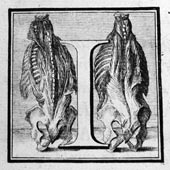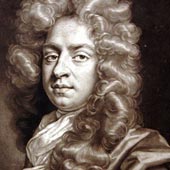Cabinet 18: Type and Typographers

William Cowper
Upon completing his medical apprenticeship, William Cowper (1666-1709), a surgeon, anatomist and skilled draughtsman, began to study the muscles of the human body in depth. Cowper published Myotomia Reformata in 1694. With assistance from physician Richard Mead (1673-1754) and engraver Michael Vandergucht (1660-1725), he published a second edition of Myotomia Reformata in 1724. Cowper designed historiated copperplate initials to feature at the beginning of the Preface, Introduction and the 36 chapters for the second edition. The initials A, C, E, F, G, I, S, T - some of which had several versions made - measure 59mm square (Mark A. Sanders). On display is Myotomia Reformata (1724) open to the Preface featuring the initial I, and enlargements of a selection of other initials found in this edition. The scene depicted in each initial relates to the content of the chapter, or section of text, it appears at the beginning of.
William Cowper, Myotomia Reformata. London, R. Knaplock [etc.] 1724. Medical: Monro Collection M53

Mezzotint engraving of William Cowper by John Smith (1654-1727) based on an oil painting by John Closterman (1656-1713).
'Frontispiece’ [Photograph]. In William Cowper, The anatomy of humane bodies, with figures drawn after the life by some of the best masters ... and ... engraven in one hundred and fourteen copper plates ... containing many new anatomical discoveries ... To which is added an introduction explaining the animal oeconomy ... Walford, London, 1698. Medical: Monro Collection M52

Type in the Digital Age
Just as manuscript alphabets were superseded by the development of woodcut and metal-cut type for printing presses so too have these methods been superseded by further manufacturing technologies, including digital technologies. Richard Southall's Printer's type in the twentieth century outlines the development of type "from hand punch-cutting through hot-metal and photographic composition to laser image setting and the PostScript revolution" (cover). Computers now have an established role in typography, with programs enabling design, easy access to and use, of a vast array of fonts.
Richard Southall, Printer's type in the twentieth century: manufacturing and design methods. London: British Library; New Castle, DE: Oak Knoll Press, 2005. Central Z250.A2 SQ16

Designing Alphabets
Styles of lettering from the earliest manuscripts to today's digital productions have all been designed by calligraphers, ornament designers and typographers, many of whom lent their name to the alphabets they designed. Some well-known designers and their designs include; John Baskerville (1706-1775) Baskerville, Giovanni Battista Bodoni (1740-1813) Bodoni, William Caslon (1692-1766) Caslon, and Frank Hinman Pierpont (1860-1937) Platin.
Appendix 2 of Christopher Perfect's Rookledge's classic international offers brief accounts of many prominent designers of type, including Claude Garamond (c1480-1561) and Joseph Fry (1728-1787).
Christopher Perfect, Rookledge's classic international type finder: the essential handbook of typeface recognition and selection. London: Laurence King Pub in association with Collins Design, 2004. Central Z250 .PD97 2004

Specimen books, manuals and handbooks
On display, open to pages displaying two different types - Fry's Ornamental and Garamond - is Type for books: a designer's manual. Specimen books, manuals and handbooks provide a format for alphabets to be presented and offer a means of identifying letters and inspiring new designs. Erhart Ratdolt (d.1528) a 15th century printer issued "the first of all Type Specimen sheets showing all fourteen varieties of type then in his possession"(Goldschmidt) in 1486.

